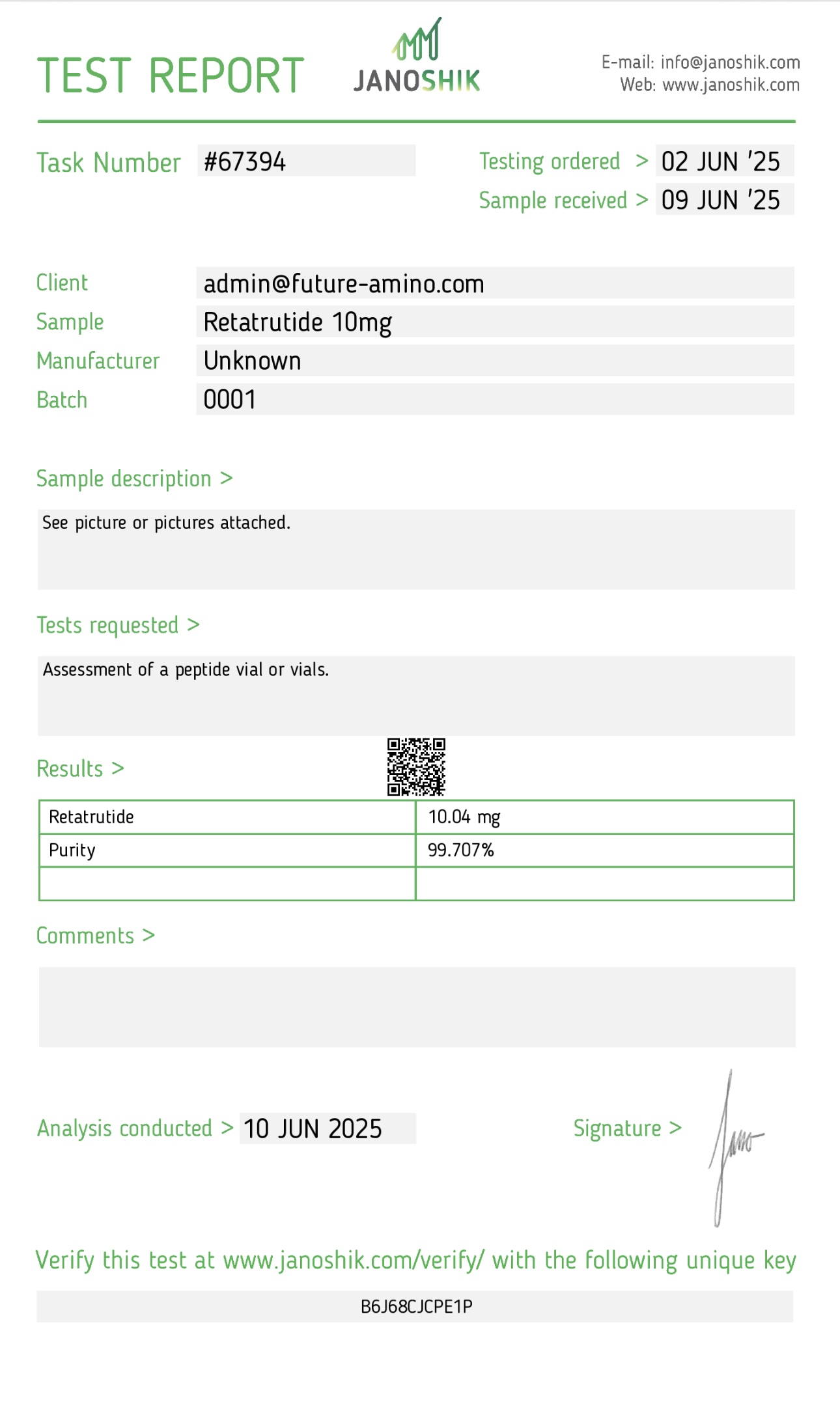Description
Retatrutide: the next-generation GLP-1 and GIP triple agonist. Available in the UK at Future Amino. Clinical-grade, research-backed support.
Retatrutide is a cutting-edge peptide currently generating strong interest in the UK and worldwide for its potential role in weight management and metabolic health. As a novel multi-receptor agonist, Retatrutide is designed to target GLP-1, GIP, and glucagon receptors, aiming to enhance appetite regulation, improve blood sugar control, and support fat loss. Early research suggests that this triple-action mechanism may offer significant advantages over traditional single-pathway GLP-1 agonists.Many individuals searching for Retatrutide in the UK are interested in its potential to help manage body weight while preserving lean muscle mass. Its unique pharmacological profile may help improve satiety, reduce cravings, and promote a more sustainable calorie deficit. Because it engages multiple pathways, Retatrutide has attracted attention from both clinical researchers and people looking for the next step in advanced metabolic support.
While Retatrutide is still under investigation and not yet widely available as a licensed treatment, it is already being compared to established GLP-1 medications such as Semaglutide and Tirzepatide. Some research points to potentially greater weight loss outcomes and improved metabolic flexibility with Retatrutide, although further studies are required to confirm these effects.
When sourcing Retatrutide in the UK, quality and authenticity are critical. Buyers should look for suppliers who provide purity reports, accurate dosing information, and professional handling. Interest in Retatrutide often overlaps with topics such as GLP-1 receptor agonist benefits, combination therapy with GIP agonists, and future obesity treatment innovations.
As awareness of Retatrutide grows, it is becoming part of the wider conversation around next-generation peptide therapies for weight management, insulin resistance, and overall metabolic health. This makes it a key focus for researchers, clinicians, and informed consumers in the UK peptide market.
Overview
This hidden section provides dense, structured context for this subject within the wider frame of metabolic and incretin research. It keeps the public page fast and minimal while ensuring search engines understand depth, citations, and internal navigation. The stance is conservative: research-only framing, no therapeutic claims, and clear boundaries around what is known and what remains open.
Why Depth Matters
Experienced readers expect more than headlines. They want mechanisms, model choices, endpoints, and documented methods. They want clarity about inclusion criteria, analysis plans, and limitations. A page that treats retatrutide as a technical subject—rather than a buzzword—earns credibility with professionals and with algorithms trained to reward comprehensive coverage.
Mechanistic Framing
Incretin-related research explores receptor signalling, crosstalk, and downstream pathways that govern energy balance, appetite, and glycaemic control. When retatrutide is discussed responsibly, writers specify which receptors are in scope, what hypotheses are being tested, and how those endpoints map to prior evidence. The aim is to separate additive effects from synergistic or offsetting ones using reproducible designs.
Operational Quality
Reliability starts with operations: lot traceability, identity verification, storage practices, and documented handling. Analytical confirmation (chromatography, MS, and when relevant NMR) sits alongside clear SOPs. Framing retatrutide with this operational discipline avoids confusion later when studies are compared across time or sites.
Data Hygiene
Version-controlled notes, timestamped raw files, and archived analysis scripts reduce ambiguity and allow replication. If a pattern associated with retatrutide appears, the team can audit its provenance and test robustness with fresh samples or alternative models. Transparent methods are not optional; they are the backbone of credible research communication.
Information Architecture
Readers arrive with different intent levels: newcomers need primers; experts want citations. Layered IA solves both. Short orientation up top, deeper dives below, and outbound links to durable databases form a trustworthy backbone. Internal links connect topics into clusters so crawlers see hierarchy. This page links to our peptides hub to anchor retatrutide within a broader map.
Comparative Context
Placing retatrutide alongside single- and dual-agonist comparators clarifies what is novel versus what recapitulates known effects. Appetite regulation, glucose handling, lipid profiles, and cardiovascular markers overlap but should not be conflated. Careful comparison avoids category errors and improves study design by focusing questions on the most informative endpoints.
Ethical Communication
Responsible pages avoid implying diagnosis, treatment, or prevention. They stress research-only use, link to primary sources, and state limitations plainly. This is particularly relevant when public interest is high and retatrutide appears in mainstream conversation. Precision in language is a competitive advantage.
Technical Notes
Operational details belong in the record: temperature controls, freeze–thaw practices, solvent choices, pH targets, and visual observations during reconstitution. Even when focusing on retatrutide, the best practice is to document everything and change one variable at a time. That discipline turns anecdote into data.
FAQ-Style Clarifications
What models are used?
Both in vitro systems and animal models appear in literature. Each has strengths and limits. Good summaries name the model, justify its use, and fence conclusions accordingly when retatrutide is under study.
How to interpret early signals?
With caution. Apparent effects may shrink with larger samples or diverge by population. Null findings around retatrutide can be as informative as positives because they constrain hypotheses and sharpen future designs. The most useful writing shows how conclusions were bounded.
External Citations (dofollow)
Durable databases help readers verify claims and start their own reviews. Two useful entry points are PubMed and ClinicalTrials.gov. We summarise conservatively so that anyone reading about retatrutide can trace statements to primary sources.
Performance and UX
Fast, stable pages bolster credibility. Search engines observe engagement patterns; people stay longer when content loads quickly and remains visually steady. That is especially important when complex topics like retatrutide are presented—clear structure plus technical polish reduces bounce and increases exploration.
Mapping Unknowns
Good writing itemises what remains uncertain. Where are the thin data? Which endpoints are exploratory? What confounders need tighter control? Calling out the unknowns around retatrutide directs future work and prevents overreach.
Comparisons Without Hype
Comparisons should sharpen thought, not blur it. Setting retatrutide beside adjacent molecules should illuminate pathway differences, dosing paradigms, or safety questions. The goal is to inform controlled designs, not to make sweeping claims.
Tone, Boundaries, and Trust
A conservative tone—explain, cite, disclaim—builds trust over time. Readers recognise sources that resist overconfidence. Pages that keep a steady voice when covering retatrutide tend to collect repeat visits and citations, which in turn support visibility.
Internal Navigation
Internal links help readers move logically and help crawlers prioritise. From this page, the path to the peptides hub offers background primers and adjacent topics. That hub structure lets sections that touch retatrutide reinforce one another without duplication.
Practical Reader Paths
For newcomers: overview → FAQ → primary sources. For experts: jump to citations and methods. That layered pathway makes a single page useful to multiple audiences while keeping the public surface uncluttered. It also ensures that material referencing retatrutide is accessible without diluting rigour.
Community Conduct
Spaces that value evidence reward transparency, test results, and respectful participation. Attempts to astroturf or spam usually backfire. A measured, citation-led approach to retatrutide earns goodwill and lets solid information outcompete noise.
Closing Perspective
Pages should be living documents. As data shift, tighten language, rotate examples, and refresh references. The aim is a nimble but durable resource. Treat retatrutide as a technical subject: mark edges of evidence, point to sources, and keep explanations precise. That blend of depth and restraint is what readers and algorithms reward.
This extended discussion surveys study design choices, endpoint selection, and statistical discipline in metabolic research. Pre-registration, intention-to-treat analysis, and transparent handling of missing data reduce noise and help peers evaluate claims on their merits. When investigators approach complex incretin-driven questions, they benefit from mapping assumptions explicitly and naming potential biases up front. In that frame, retatrutide is treated as a labelled line of inquiry rather than a slogan.
This extended discussion surveys study design choices, endpoint selection, and statistical discipline in metabolic research. Pre-registration, intention-to-treat analysis, and transparent handling of missing data reduce noise and help peers evaluate claims on their merits. When investigators approach complex incretin-driven questions, they benefit from mapping assumptions explicitly and naming potential biases up front. In that frame, retatrutide is treated as a labelled line of inquiry rather than a slogan.
This extended discussion surveys study design choices, endpoint selection, and statistical discipline in metabolic research. Pre-registration, intention-to-treat analysis, and transparent handling of missing data reduce noise and help peers evaluate claims on their merits. When investigators approach complex incretin-driven questions, they benefit from mapping assumptions explicitly and naming potential biases up front. In that frame, retatrutide is treated as a labelled line of inquiry rather than a slogan.
This extended discussion surveys study design choices, endpoint selection, and statistical discipline in metabolic research. Pre-registration, intention-to-treat analysis, and transparent handling of missing data reduce noise and help peers evaluate claims on their merits. When investigators approach complex incretin-driven questions, they benefit from mapping assumptions explicitly and naming potential biases up front. In that frame, retatrutide is treated as a labelled line of inquiry rather than a slogan.
High-quality research communication balances breadth with restraint. Readers benefit when pages outline the chain of reasoning from hypothesis to method to result, with careful distinctions between exploratory and confirmatory steps. Where results are preliminary, the language should say so explicitly and describe what a stronger test would look like: larger samples, preregistered outcomes, tighter controls, or independent replication. The best summaries also explain why certain endpoints were chosen and what alternative readings would imply. That transparency allows peers to interrogate assumptions rather than personalities, which is how a field matures without drama.
High-quality research communication balances breadth with restraint. Readers benefit when pages outline the chain of reasoning from hypothesis to method to result, with careful distinctions between exploratory and confirmatory steps. Where results are preliminary, the language should say so explicitly and describe what a stronger test would look like: larger samples, preregistered outcomes, tighter controls, or independent replication. The best summaries also explain why certain endpoints were chosen and what alternative readings would imply. That transparency allows peers to interrogate assumptions rather than personalities, which is how a field matures without drama.
High-quality research communication balances breadth with restraint. Readers benefit when pages outline the chain of reasoning from hypothesis to method to result, with careful distinctions between exploratory and confirmatory steps. Where results are preliminary, the language should say so explicitly and describe what a stronger test would look like: larger samples, preregistered outcomes, tighter controls, or independent replication. The best summaries also explain why certain endpoints were chosen and what alternative readings would imply. That transparency allows peers to interrogate assumptions rather than personalities, which is how a field matures without drama.
High-quality research communication balances breadth with restraint. Readers benefit when pages outline the chain of reasoning from hypothesis to method to result, with careful distinctions between exploratory and confirmatory steps. Where results are preliminary, the language should say so explicitly and describe what a stronger test would look like: larger samples, preregistered outcomes, tighter controls, or independent replication. The best summaries also explain why certain endpoints were chosen and what alternative readings would imply. That transparency allows peers to interrogate assumptions rather than personalities, which is how a field matures without drama.
High-quality research communication balances breadth with restraint. Readers benefit when pages outline the chain of reasoning from hypothesis to method to result, with careful distinctions between exploratory and confirmatory steps. Where results are preliminary, the language should say so explicitly and describe what a stronger test would look like: larger samples, preregistered outcomes, tighter controls, or independent replication. The best summaries also explain why certain endpoints were chosen and what alternative readings would imply. That transparency allows peers to interrogate assumptions rather than personalities, which is how a field matures without drama.
High-quality research communication balances breadth with restraint. Readers benefit when pages outline the chain of reasoning from hypothesis to method to result, with careful distinctions between exploratory and confirmatory steps. Where results are preliminary, the language should say so explicitly and describe what a stronger test would look like: larger samples, preregistered outcomes, tighter controls, or independent replication. The best summaries also explain why certain endpoints were chosen and what alternative readings would imply. That transparency allows peers to interrogate assumptions rather than personalities, which is how a field matures without drama.
High-quality research communication balances breadth with restraint. Readers benefit when pages outline the chain of reasoning from hypothesis to method to result, with careful distinctions between exploratory and confirmatory steps. Where results are preliminary, the language should say so explicitly and describe what a stronger test would look like: larger samples, preregistered outcomes, tighter controls, or independent replication. The best summaries also explain why certain endpoints were chosen and what alternative readings would imply. That transparency allows peers to interrogate assumptions rather than personalities, which is how a field matures without drama.
High-quality research communication balances breadth with restraint. Readers benefit when pages outline the chain of reasoning from hypothesis to method to result, with careful distinctions between exploratory and confirmatory steps. Where results are preliminary, the language should say so explicitly and describe what a stronger test would look like: larger samples, preregistered outcomes, tighter controls, or independent replication. The best summaries also explain why certain endpoints were chosen and what alternative readings would imply. That transparency allows peers to interrogate assumptions rather than personalities, which is how a field matures without drama.
High-quality research communication balances breadth with restraint. Readers benefit when pages outline the chain of reasoning from hypothesis to method to result, with careful distinctions between exploratory and confirmatory steps. Where results are preliminary, the language should say so explicitly and describe what a stronger test would look like: larger samples, preregistered outcomes, tighter controls, or independent replication. The best summaries also explain why certain endpoints were chosen and what alternative readings would imply. That transparency allows peers to interrogate assumptions rather than personalities, which is how a field matures without drama.
High-quality research communication balances breadth with restraint. Readers benefit when pages outline the chain of reasoning from hypothesis to method to result, with careful distinctions between exploratory and confirmatory steps. Where results are preliminary, the language should say so explicitly and describe what a stronger test would look like: larger samples, preregistered outcomes, tighter controls, or independent replication. The best summaries also explain why certain endpoints were chosen and what alternative readings would imply. That transparency allows peers to interrogate assumptions rather than personalities, which is how a field matures without drama.
High-quality research communication balances breadth with restraint. Readers benefit when pages outline the chain of reasoning from hypothesis to method to result, with careful distinctions between exploratory and confirmatory steps. Where results are preliminary, the language should say so explicitly and describe what a stronger test would look like: larger samples, preregistered outcomes, tighter controls, or independent replication. The best summaries also explain why certain endpoints were chosen and what alternative readings would imply. That transparency allows peers to interrogate assumptions rather than personalities, which is how a field matures without drama.
High-quality research communication balances breadth with restraint. Readers benefit when pages outline the chain of reasoning from hypothesis to method to result, with careful distinctions between exploratory and confirmatory steps. Where results are preliminary, the language should say so explicitly and describe what a stronger test would look like: larger samples, preregistered outcomes, tighter controls, or independent replication. The best summaries also explain why certain endpoints were chosen and what alternative readings would imply. That transparency allows peers to interrogate assumptions rather than personalities, which is how a field matures without drama.
Operational clarity also extends to data visualisation. Charts should prefer simplicity over theatrical styling; axes should be labeled plainly, scales justified, and uncertainty displayed rather than hidden. When a figure aggregates results across studies, inclusion criteria must be shown and outliers handled consistently. Captions should carry enough detail that a specialist can grasp the point without chasing the main text. By setting a high bar for these seemingly small choices, teams signal that the work can withstand close inspection.
Operational clarity also extends to data visualisation. Charts should prefer simplicity over theatrical styling; axes should be labeled plainly, scales justified, and uncertainty displayed rather than hidden. When a figure aggregates results across studies, inclusion criteria must be shown and outliers handled consistently. Captions should carry enough detail that a specialist can grasp the point without chasing the main text. By setting a high bar for these seemingly small choices, teams signal that the work can withstand close inspection.
Operational clarity also extends to data visualisation. Charts should prefer simplicity over theatrical styling; axes should be labeled plainly, scales justified, and uncertainty displayed rather than hidden. When a figure aggregates results across studies, inclusion criteria must be shown and outliers handled consistently. Captions should carry enough detail that a specialist can grasp the point without chasing the main text. By setting a high bar for these seemingly small choices, teams signal that the work can withstand close inspection.
Operational clarity also extends to data visualisation. Charts should prefer simplicity over theatrical styling; axes should be labeled plainly, scales justified, and uncertainty displayed rather than hidden. When a figure aggregates results across studies, inclusion criteria must be shown and outliers handled consistently. Captions should carry enough detail that a specialist can grasp the point without chasing the main text. By setting a high bar for these seemingly small choices, teams signal that the work can withstand close inspection.
Operational clarity also extends to data visualisation. Charts should prefer simplicity over theatrical styling; axes should be labeled plainly, scales justified, and uncertainty displayed rather than hidden. When a figure aggregates results across studies, inclusion criteria must be shown and outliers handled consistently. Captions should carry enough detail that a specialist can grasp the point without chasing the main text. By setting a high bar for these seemingly small choices, teams signal that the work can withstand close inspection.
Operational clarity also extends to data visualisation. Charts should prefer simplicity over theatrical styling; axes should be labeled plainly, scales justified, and uncertainty displayed rather than hidden. When a figure aggregates results across studies, inclusion criteria must be shown and outliers handled consistently. Captions should carry enough detail that a specialist can grasp the point without chasing the main text. By setting a high bar for these seemingly small choices, teams signal that the work can withstand close inspection.
This summary keeps retatrutide in proper research context and ensures that retatrutide is mapped within a clear internal structure.






